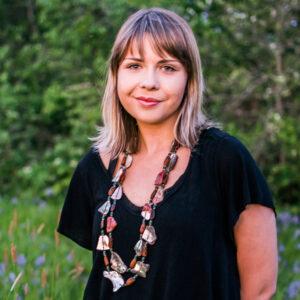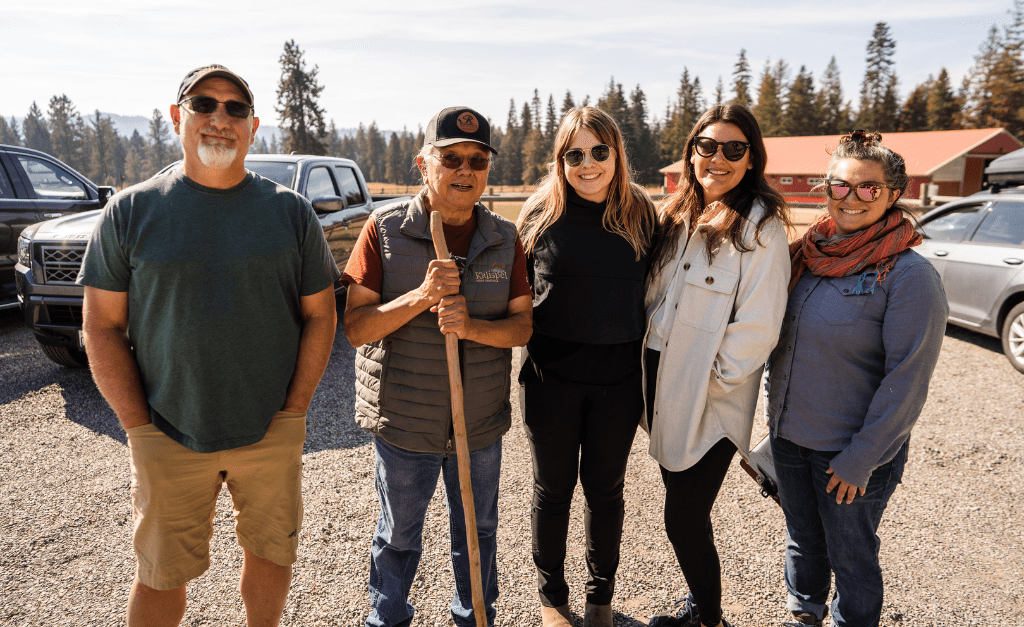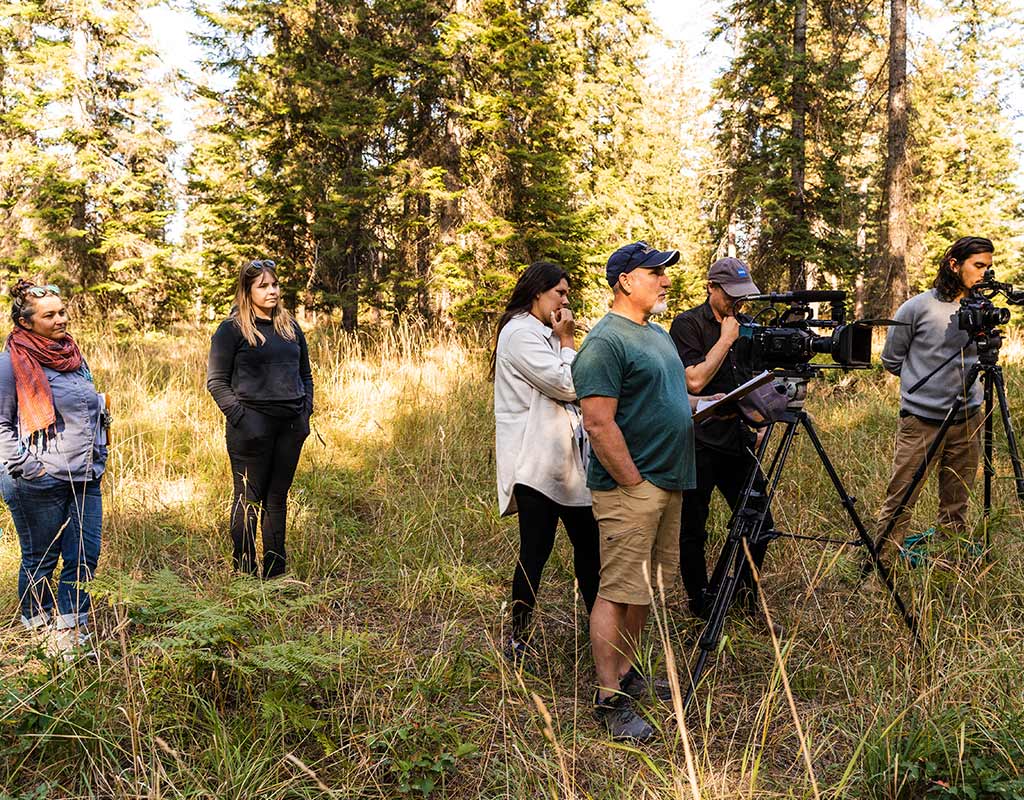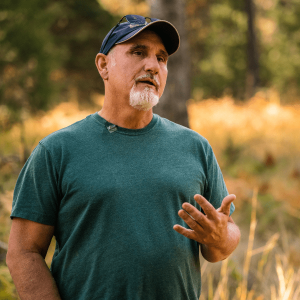
Indigenous Storytelling & Engagement Fellow
The mouth of Indian Creek meets the Pend Oreille River near the Kalispel Community Forest. Photo credit: Sean Gutierrez
Indigenous storytelling and engagement fellow, Jessica Douglas, reflects on a visit with Ecotrust partners at the Kalispel Tribe.
On an early October morning, I piled into the car of my coworker, Megan Foucht. We departed from our cozy cabin at the Kalispel Tribal RV park and crossed the wide, slow-moving Pend Oreille River, a tributary of the Columbia River. The fog, which hung low to the plots of grassy farmland, began to lift, and we spotted a coyote making its way through a dewy field.
Just as the sun peeked over the mountains, we arrived at Indian Creek Community Forest for the first of three days of filming with the Kalispel Natural Resource Department (KNRD). We pulled into a parking spot next to the Kalispel native plant nursery and were greeted by Ray Entz, director of wildlife and terrestrial resources for the Kalispel Tribe, and Mike Lithgow, outreach coordinator and policy analyst for the Kalispel Tribe.

Ray Entz, director of wildlife and terrestrial resources for the Kalispel Tribe, Francis Cullooyah, culture director for the Kalispel Tribe, pose with Ecotrust staff, Jessica Douglas, Stephanie Gutierrez, and Megan Foucht at the Kalispel Community Forest. Photo credit: Sean Gutierrez
For the past couple of weeks, Ecotrust staff including Stephanie Gutierrez, forest and community program director; Megan Foucht, senior communications manager; and myself have been meeting with Ray and Mike to collaborate on a storytelling narrative for a video that centers the holistic land management practices of KNRD.
On this day, we finally had the opportunity to meet Ray and Mike in person. We spent the morning exploring the Indian Creek Community Forest, taking in portions of the 410-acre, diverse forested landscape where the Tribe has opened its doors for the community to learn about KNRD’s stewardship approaches and the local forest ecosystem and enjoy outdoor environmental education and recreation.

Mike Lithgow, outreach coordinator and policy analyst for the Kalispel Tribe, and Ray Entz, director of wildlife and terrestrial resources for the Kalispel Tribe. Photo credit: Sean Gutierrez

Ray and Mike introduced us to Francis Cullooyah, culture director and Kalispel tribal elder, whom we had the pleasure of interviewing among some of the western white pine trees in the community forest. Francis graciously shared with us his time and knowledge as a cultural bearer and Kalispel language speaker within the community.
“
The forest and the water, the connection, it’s all very simple: One can’t exist without the other.
—Francis Cullooyah
“The forest and the water, the connection, it’s all very simple: One can’t exist without the other.” Francis said. “The water is of utmost importance to all of our Native people because of what it does. It brings us life. It brings us the fisheries. It brings us the four-legged. It brings us the birds and everything that surrounds us, that gives us life. It sustained us for so many years, and it still does today, as water people, as river people.”
“‘Ntxwe’ we call the river,” Francis said in the Kalispel language. It was ntxwe, the Pend Oreille River, which bound together one end of the Kalispel country to the other, some 200 miles in length.

A behind-the-scenes look into our interview methods for filming the KNRD video. Photo credit: Sean Gutierrez
After enjoying our sack lunch and basking in the unusually warm October sun, a highlight of our time was driving three off-road buggies to further explore the Indian Creek Community Forest and visit the small landowner demonstration forest. The demonstration forest features nine different forest management units across 100 acres, where KNRD has applied techniques such as thinning and prescribed burns to produce a healthy forest. These units with varying prescriptions were created to demonstrate a variety of methods for small forest landowners, who can visit the community forestry to compare and contrast the different techniques and costs before applying them to their own small forest.
Nearby, we saw one of KNRD’s active projects, a six-acre western white pine progeny site. Western white pine is one of the most culturally significant species for the Kalispel people because of its cambium layer of bark that is utilized for the Kalispel sturgeon nose canoe, a canoe style unique to the Kalispel people. KNRD is currently working to promote white pine recovery by testing different genetic families that may or may not have resiliency to white pine blister rust, a non-native fungus that threatens current tree populations.

Members of Patuá Films take a break in the Indian Creek Community Forest. Photo credit: Jessica Douglas

Ecotrust employees Jessica Douglas, Megan Foucht, and Stephanie Gutierrez drive an off-road side-by-side on a tour through the Indian Creek Community Forest. Photo credit: Sean Gutierrez
Over the course of the next two days of filming, we interviewed several KNRD employees. We listened and learned about the variety of restoration work that benefits not only Kalispel tribal members, but also the broader Pend Oreille River community.
This work includes a water refugia project that restores and protects threatened native bull trout fish populations, a staple food source for the Tribe, at the headwater of Indian Creek. Another example is a project that restores past farmland to traditional wetland habitat and will foster native plant and root species grown by the Tribe’s own native plant nursery. All are examples of how KNRD considers a variety of factors and community concerns in their stewardship practices.
“We consider climate in everything that we plan and do. But we really don’t know what the future looks like, so we’re taking cues that the environment and the forest [are] giving us today and making decisions,” Ray said. “But our knowledge base is going to change over time. And as it changes, we will change our management perspective.”

“
We consider climate in everything that we plan and do. But we really don’t know what the future looks like, so we’re taking cues that the environment and the forest [are] giving us today and making decisions.
—RAY ENTZ
We witnessed first hand KNRD’s collaborative approach to land stewardship, working in partnership with state, local, federal, and private agencies. Our conversations left us feeling inspired, motivated, and grateful for the time to come together in-person.
In a rapidly changing climate, it is critical that we continue to build relationships with our partners and uplift the voices of the Indigenous communities that carry traditional ecological knowledge, especially those who have been systematically excluded from the climate crisis conversation.
We hope our work together can change the climate narrative and empower our partners to voice their own stories. This idea, in part, led us to partner with KNRD. As a result, together Ecotrust, Patuá Films, and KNRD worked to produce a video that was first and foremost driven by KNRD and for the Kalispel tribal community.
Members of the Kalispel Tribe’s Natural Resource Department and the Tribe’s Culture Director discuss the relationship between forests and water, and the ways the Tribe is working to understand and respond to the impacts of climate change for culturally important Whitebark Pine and Bull trout. Video credit: Patuá Films
